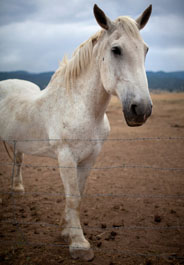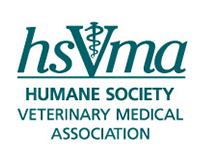Veterinary Community Can and Should Help Owners of At-Risk Horsesby Grant Miller, DVM October 12, 2012  Erin Hooley for The HSUS As our economy continues to sputter and stagger along, horse owners are increasingly feeling financial pressures associated with feeding and caring for their hoofed pets. Rising hay and fuel prices, low real estate values, and record high unemployment rates have contributed to a “perfect storm” in which more and more horses are becoming at risk. When financial hardships become too much to bear, horses stare into the eye of that perfect storm before others do, mainly because the money spent to keep them fed and dry is discretionary. Discretionary money is the same money people use to purchase movie tickets or to buy Porsches. Unfortunately, when discretionary money runs out, Porsches can be garaged and movies can be watched at home, but horses still require regular food, hoof care, and veterinary attention. As a result, equine companions are taking the brunt of the economic storm. Statistics compiled by the USDA Agricultural Marketing Service indicate that in this economic crisis, horses are being shipped out of the country for slaughter to both Mexico and Canada at an increasing rate. According to the report, the United States exported nearly 22,000 live horses to Canada and more than 11,000 to Mexico in 2006. In 2007, the year that the three remaining U.S. horse slaughter plants closed, approximately 32,500 U.S. horses went to Canada and approximately 45,600 went to Mexico. In 2008, Canada and Mexico imported approximately 42,200 and 56,700 U.S. horses, respectively. In 2010, government statistics show that nearly 106,700 American horses were sold and killed for meat in other countries. Of the approximately 9 million horses in the United States, this is still a relatively small fraction of our overall horse population. The overwhelming majority of horse owners do not consider slaughter as an option for ending the lives of their horses. However, when one considers that many of the horses that do go to Mexico and Canada face overcrowding, hunger, thirst, injury and even death on the trip, and then are often conscious during slaughter, we must ask: How can we help prevent this suffering? As veterinarians, we are uniquely positioned within our communities to intervene on behalf of these majestic creatures to ensure that they are not included in the statistics above. We possess knowledge and connections in our locales that can benefit our clients and most importantly, their horses. Develop an "At-Risk Horse Resource Sheet"Many horse owners are embarrassed to bring up the subject of economic hardship. For that reason, some wait until the last minute to inform their veterinarian that they must seek alternatives for their horse. Many people are leaving foreclosed homes and are considering leaving their horses behind, while others have no spare money or time to figure out a solution. BE PREPARED! Have an information sheet ready that educates owners about options for their horses. The sheet should seek to fully inform owners about what will happen should they choose to send their horse to an auction, versus what will occur if they opt for humane euthanasia. Our role as educators can be very instrumental in shaping the outcome of these unfortunate situations. Here are some options to include when formulating your "At-Risk Horse Resource Sheet."
As veterinarians, we know a lot of folks in our communities. A simple phone call on our part may connect people and result in a humane solution for an at-risk horse. If we can each put just a bit more effort into forwarding emails about horses in need of homes to our friends and colleagues, or devoting a bulletin board in our clinic lobby for posting adoption flyers, we can dramatically change the courses of many horses’ lives. Above all, being approachable and willing and able to provide information to our clients is of the utmost importance as we navigate these difficult economic times. You can find a sample resource sheet on the Sonoma County CHANGE program's website. For assistance with an adoption questionnaire, send an email to [email protected] and a sample will be sent to you.  Grant Miller, DVM is a large animal veterinarian who has practiced in the northern San Francisco bay area for eight years. Dr. Miller has spent most of his life contributing to the equine community. He grew up riding in the Pony Clubs of America and showed competitively in dressage until he graduated from UC Davis with an Animal Science degree in 1999. He then went on to complete veterinary school at UC Davis in 2004. He currently practices part time, and works part time as the Director of Regulatory Affairs at the California Veterinary Medical Association. In addition, Miller founded a 501(c)3 corporation in 2007 called the Sonoma County CHANGE Program. This volunteer- based organization serves law enforcement as a subsidiary in equine abuse, abandonment and relinquishment cases. Dr. Miller created a community foster barn network consisting of volunteers who provide transportation and foster care service on an ongoing basis to local animal control. The organization rehabilitates horses, with Miller donating his veterinary services, and adopts horses out into new permanent homes once they are restored to health. Dr. Miller voluntarily trains law enforcement officers around the state of California through the CHANGE Program and has also donated expert witness testimony in dozens of criminal horse abuse trials. In 2010, Miller published “The Minimum Standards of Horse Care in the State of California” along with collaborators from UC Davis. The document serves law enforcement in managing equine humane cases. Dr. Miller has also published work on the feeding and rehabilitation of starved horses. |
